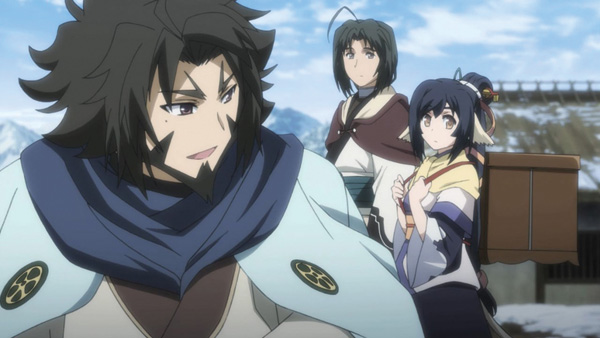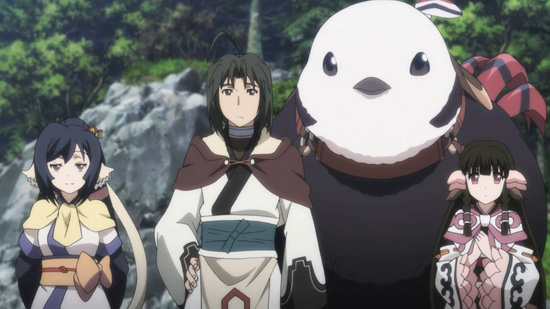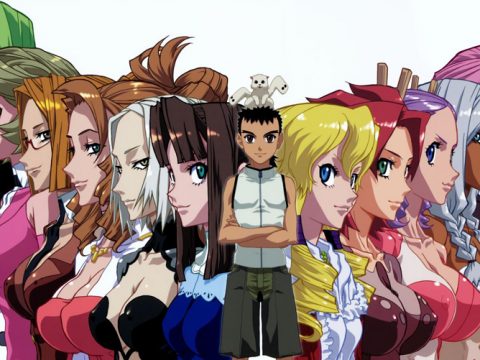
At the beginning of Utawarerumono: The False Faces, a confused young man wanders aimlessly through the snowy wilderness, barefoot and wearing only what appears to be a thin hospital gown. Soon the poor fellow is attacked by a colossal centipede and a gigantic blob of sapient protoplasm. The man is rescued by Kuon, a traveling merchant, who gives him proper winter clothing and the name “Haku”, since the young man is completely amnesiac. While journeying together to the nearest village, Haku notices that Kuon – like everyone else except himself in this fantastical world that he now inhabits – sports a pair of furry animal ears and a long, fluffy tail. Haku has no context to judge whether this is unusual, though, so he takes each new development in stride – from the presence of giant pigeons that serve as pack horses to the existence of pyrotechnic sorcery.
It’s difficult to pin down the narrative of this show, because at the time of this writing only a handful of episodes of Utawarerumono: The False Faces have been published. The nature of the plot hasn’t crystallized yet, and some of this stems from the characteristics of the protagonist. Despite missing his memories, Haku is a bit lazy and a tad pessimistic, so he spends several episodes simply trying to find his proper place within the world. In the first five episodes, there is no clear-cut antagonist nor is there any urgent, over-arching goal. Once Haku and Kuon arrive in the Capital, there are hints of intrigue: Perhaps the Emperor has some mysterious connection to Haku? Perhaps the General of the Right will embroil Haku and Kuon in secret missions involving espionage? The mystery of what will happen next is enough to keep me watching, because I’m curious to see what will happen next.

Similarly, I want to know more about this unique fantasy world. Utawarerumono: The False Faces introduces the setting without relying on the sort of clunky, exposition-heavy dialog that hamstrings other visual novel / light novel adaptations such as Overlord. The series presents an environment where magic and monsters exist, where ordinary humans are seemingly absent, and where humanoid animal-people have formed a society with a culture that is reminiscent of mythological China. The audience encounters all of these concepts gradually. We learn at the same pace as Haku, our amnesiac protagonist, and so we discover what constitutes normal in this world through a smooth and natural progression.
I’ve never played the original Utawarerumono erotic visual novel, but elements of that source material poke through in The False Faces. The series is shameless in both its male and female fan-service. It spares no opportunity for the cast to strip down and soak in the hot springs bathes, but it also inverts the “gratuitous shower scene” trope in the first episode in a genuinely humorous way. Haku appears to be accumulating quite a harem by the fifth episode, as most of the characters who gravitate toward him are young, pretty, and female. At present this aspect isn’t terribly distracting, because it is not currently the central focus of the show, and because Haku doesn’t behave like the typical audience self-insertion character. Some of the support characters are hit-or-miss. For example, there’s a flamboyantly gay character played for comic relief who wears out his welcome immediately, but there’s also a friendly pigeon the size of a small elephant, and the pigeon more than makes up for a single tired stereotype in my book.

I haven’t watched the first Utawareru-mono TV anime adaptation which aired in 2006. I understand that the earlier series goes completely bonkers during the conclusion in a way that recalls both Neon Genesis Evangelion and the original Planet of the Apes.
I suspect that Utawarerumono: The False Faces may have something similarly zany planned, but I’m willing to go along for the ride, because The False Faces pushes just the right fantasy anime buttons to keep me entertained.





![Super HxEros [Manga Review] Super HxEros [Manga Review]](https://otakuusamagazine.com/wp-content/uploads/2021/05/super-hxeros-volume-8-16-9-480x338.jpg)

